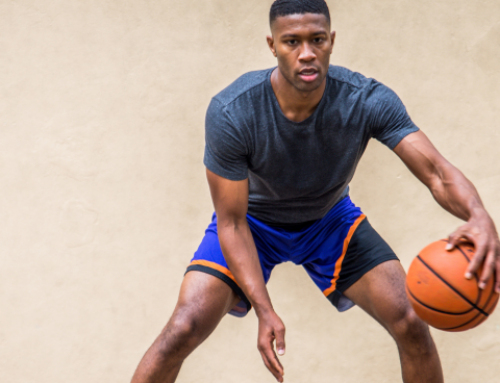Elevate Your Game With Four Basketball Conditioning Drills
On the basketball court, fatigue can be your biggest enemy, even more than a tough opponent. Fatigue can lead to poor decision-making, defensive breakdowns and faulty technique in your offensive game. Worst case scenario: exhaustion can contribute to a season-ending injury. The best players combat this through preparation. They step on the court knowing that they are in the best shape possible.
Many players make two huge mistakes when choosing basketball conditioning drills and designing their programs. First, they over-emphasize steady state or slow aerobic cardio. When exactly do you ever walk or jog during a game? We’re taught to hussle from day one. So unless you’re recovering from an injury, focus on interval training—short bursts of intense work followed by brief rest periods. Intervals are more basketball-specific.
Second, too many players neglect training for change of direction, acceleration and deceleration—all vital components of a conditioning program. These movements are also basketball-specific, and they lower the risk of injury. Most injuries occur when an athlete tries to speed up or come to a complete stop.
The drills below rectify both of these problems and prepare you for the demands of actual games. Don’t play basketball to get into shape. Get into shape to play basketball.
The Seventeen
- Begin on the sideline
- Sprint to opposite sideline and touch it with your foot. This is one line.
- Complete 17 lines as fast as you can, finishing on the side opposite from where you began.
- Time yourself and rest for the same amount of time.
- Repeat two or three times.
- Begin in one of the four corners of the court, where the baseline and sideline intersect.
- Sprint diagonally across the court to the opposite corner. If you are with a teammate, meet at half-court with a “high-five.”
- When you reach the opposite corner, open up and defensive slide along the baseline to the other corner. Focus on getting and staying low in your stance. Be explosive and use short, choppy steps.
- Sprint diagonally back down the court to the opposite corner, and defensive slide to the corner where you started.
- Complete the “X” twice in a set. Challenge yourself to see how great you can be.
- Begin on the baseline.
- Laterally slide to the free-throw line and back to the baseline.
- Sprint to half-court and back to the baseline.
- Laterally slide to the opposite free-throw line and back.
- Finally, sprint the full length of the court and return to the starting line.
- Suicides train for irregular intervals of change of direction, acceleration and deceleration.
- Do you like traditional, all forward sprint suicides? Add a basketball and work on your ball handling at the same time.
- Begin outside the lane, below the block, facing the court.
- Sprint to the elbow and perform a close-out.
- Transition to a lateral slide across the free-throw line.
- When you hit the elbow, backpedal to the baseline.
- Finish off by laterally shuffling back to start position.
- Go for 30 to 35 seconds. Rest for 30 to 35 seconds and repeat 2 or 3 times.
RECOMMENDED FOR YOU
MOST POPULAR
Elevate Your Game With Four Basketball Conditioning Drills
On the basketball court, fatigue can be your biggest enemy, even more than a tough opponent. Fatigue can lead to poor decision-making, defensive breakdowns and faulty technique in your offensive game. Worst case scenario: exhaustion can contribute to a season-ending injury. The best players combat this through preparation. They step on the court knowing that they are in the best shape possible.
Many players make two huge mistakes when choosing basketball conditioning drills and designing their programs. First, they over-emphasize steady state or slow aerobic cardio. When exactly do you ever walk or jog during a game? We’re taught to hussle from day one. So unless you’re recovering from an injury, focus on interval training—short bursts of intense work followed by brief rest periods. Intervals are more basketball-specific.
Second, too many players neglect training for change of direction, acceleration and deceleration—all vital components of a conditioning program. These movements are also basketball-specific, and they lower the risk of injury. Most injuries occur when an athlete tries to speed up or come to a complete stop.
The drills below rectify both of these problems and prepare you for the demands of actual games. Don’t play basketball to get into shape. Get into shape to play basketball.
The Seventeen
- Begin on the sideline
- Sprint to opposite sideline and touch it with your foot. This is one line.
- Complete 17 lines as fast as you can, finishing on the side opposite from where you began.
- Time yourself and rest for the same amount of time.
- Repeat two or three times.
- Begin in one of the four corners of the court, where the baseline and sideline intersect.
- Sprint diagonally across the court to the opposite corner. If you are with a teammate, meet at half-court with a “high-five.”
- When you reach the opposite corner, open up and defensive slide along the baseline to the other corner. Focus on getting and staying low in your stance. Be explosive and use short, choppy steps.
- Sprint diagonally back down the court to the opposite corner, and defensive slide to the corner where you started.
- Complete the “X” twice in a set. Challenge yourself to see how great you can be.
- Begin on the baseline.
- Laterally slide to the free-throw line and back to the baseline.
- Sprint to half-court and back to the baseline.
- Laterally slide to the opposite free-throw line and back.
- Finally, sprint the full length of the court and return to the starting line.
- Suicides train for irregular intervals of change of direction, acceleration and deceleration.
- Do you like traditional, all forward sprint suicides? Add a basketball and work on your ball handling at the same time.
- Begin outside the lane, below the block, facing the court.
- Sprint to the elbow and perform a close-out.
- Transition to a lateral slide across the free-throw line.
- When you hit the elbow, backpedal to the baseline.
- Finish off by laterally shuffling back to start position.
- Go for 30 to 35 seconds. Rest for 30 to 35 seconds and repeat 2 or 3 times.











